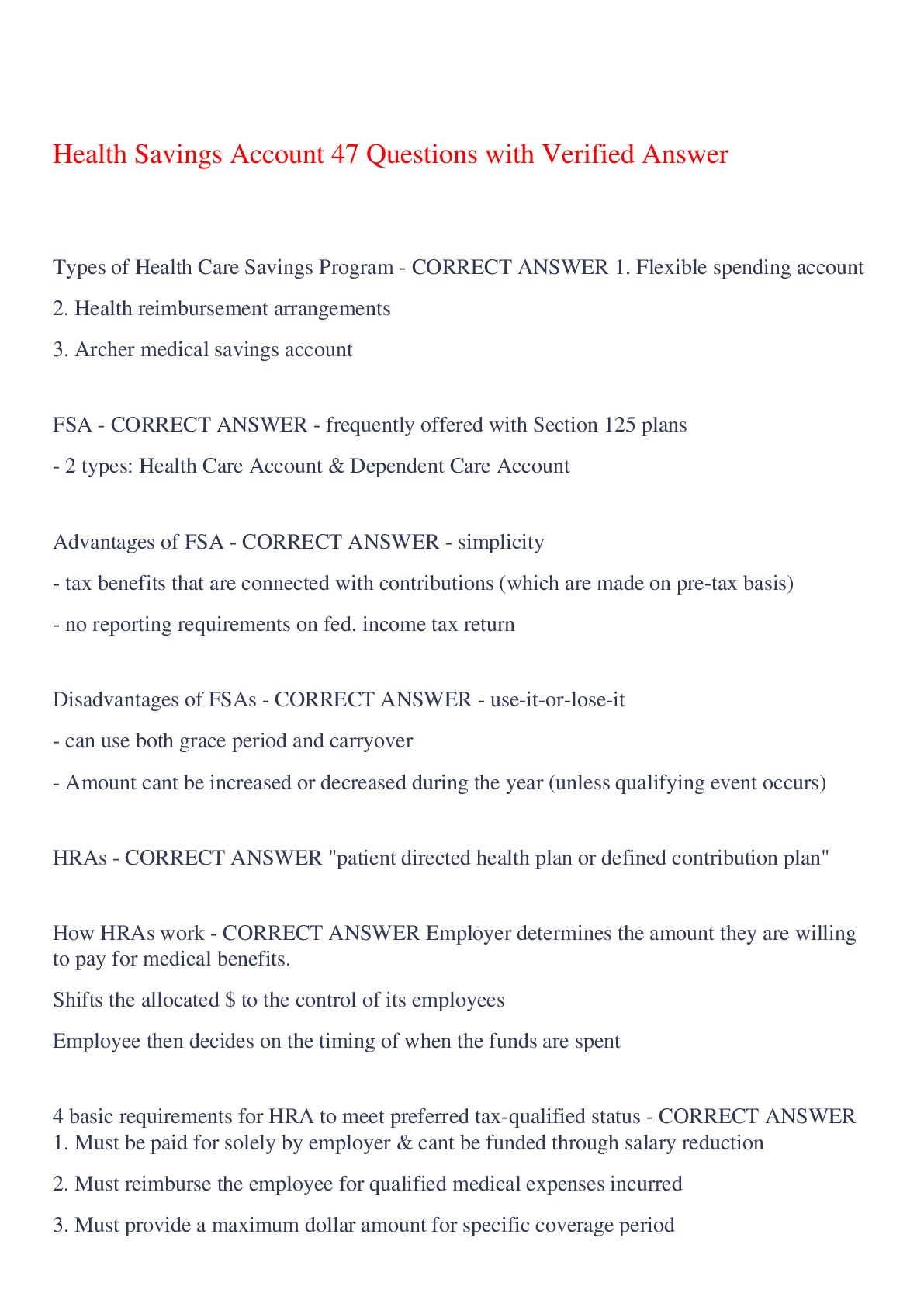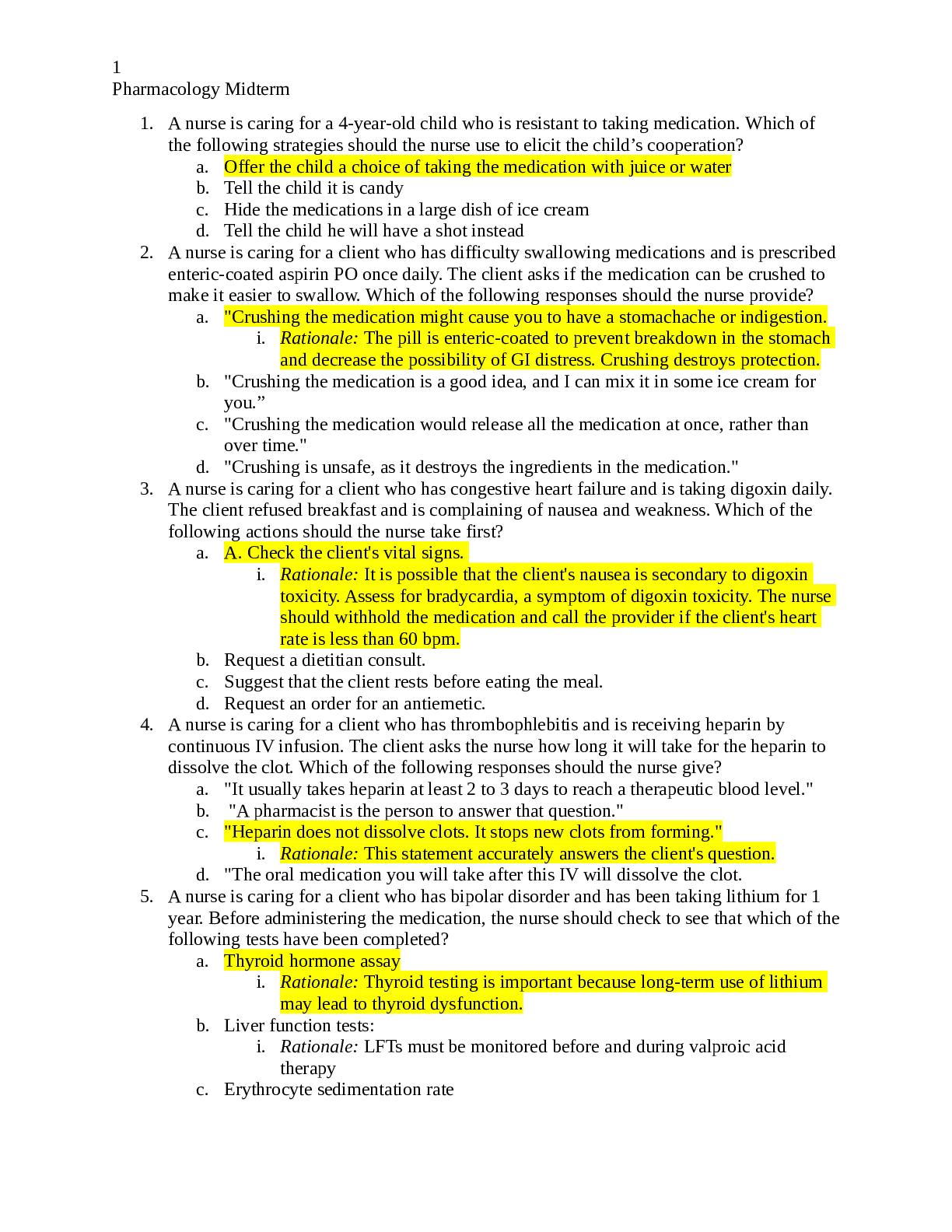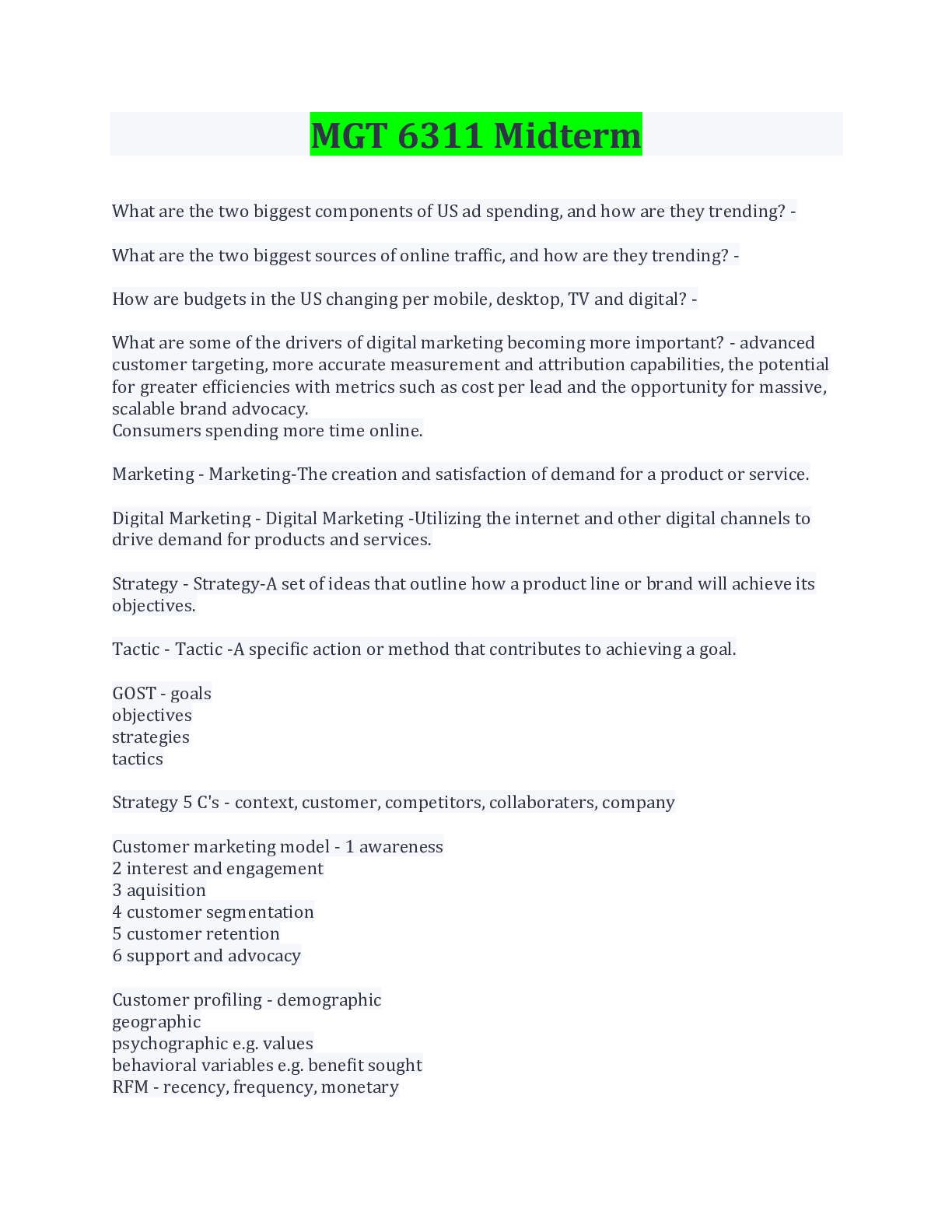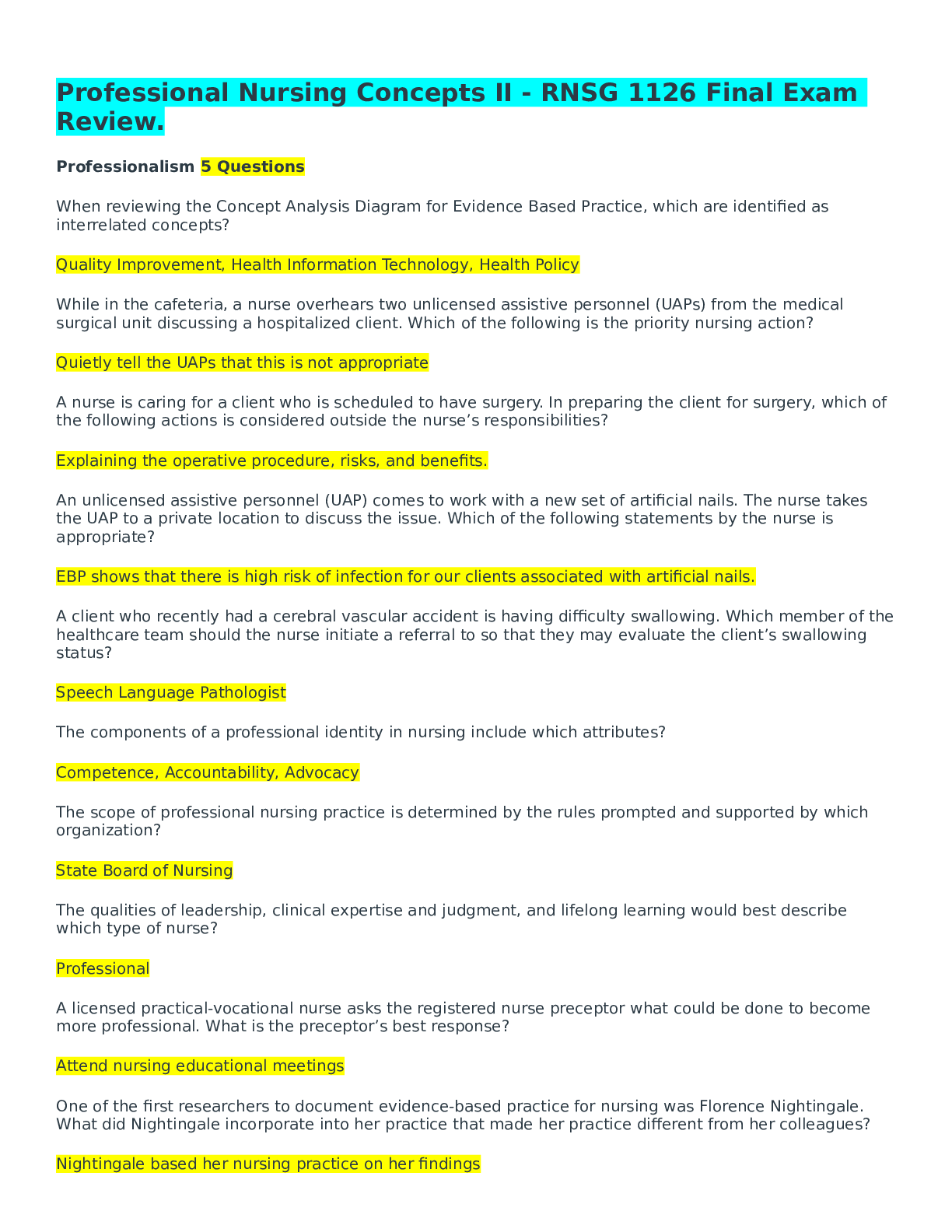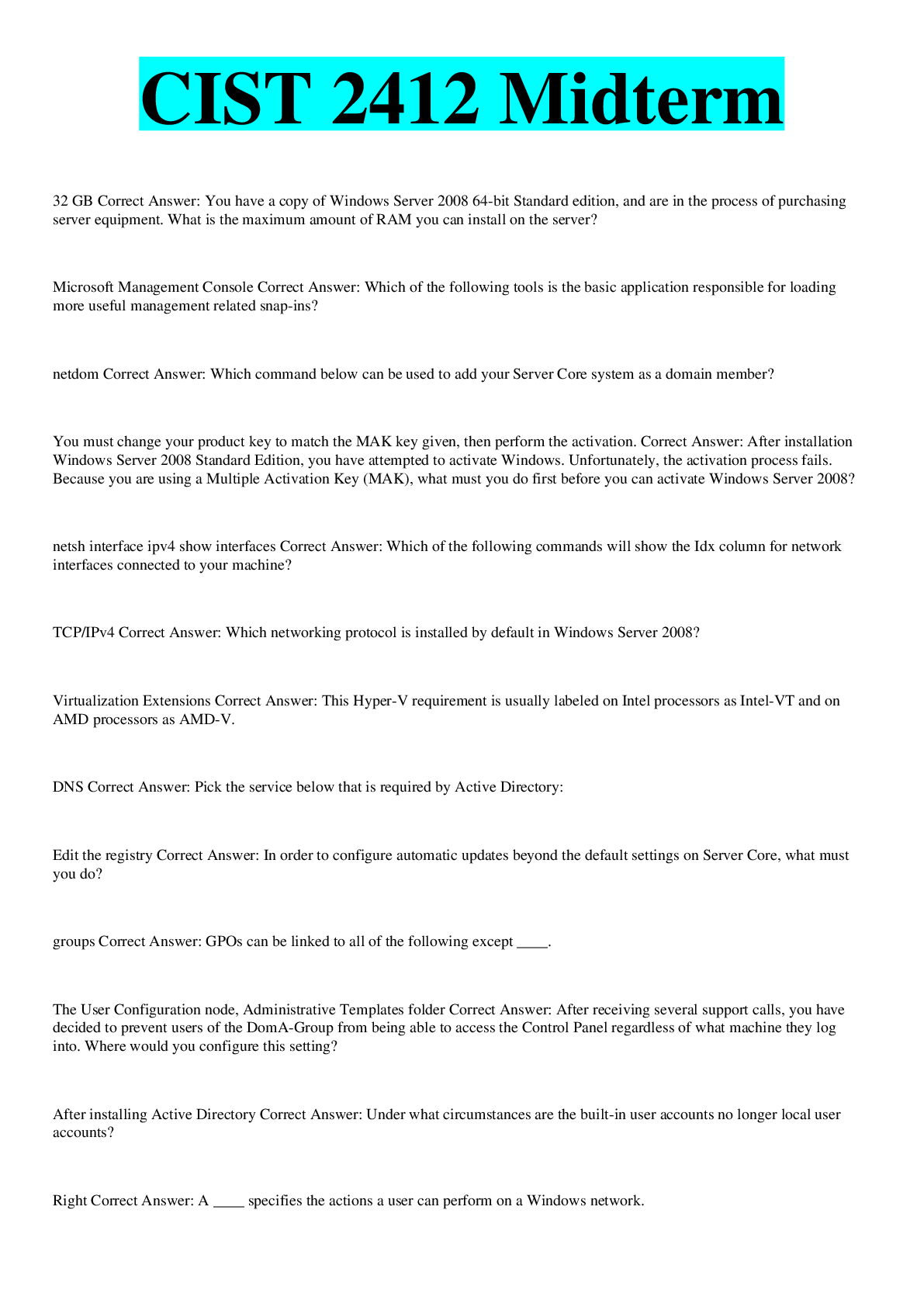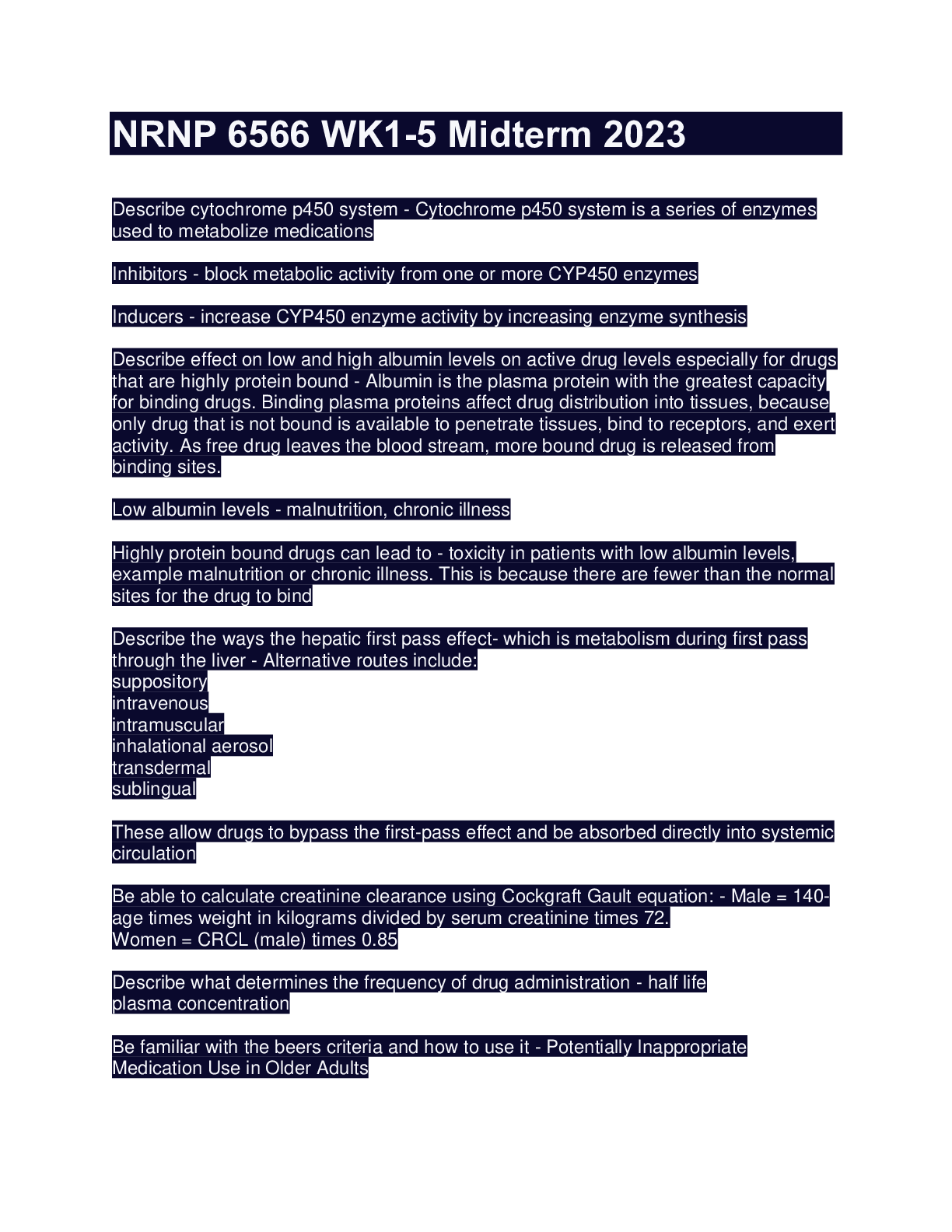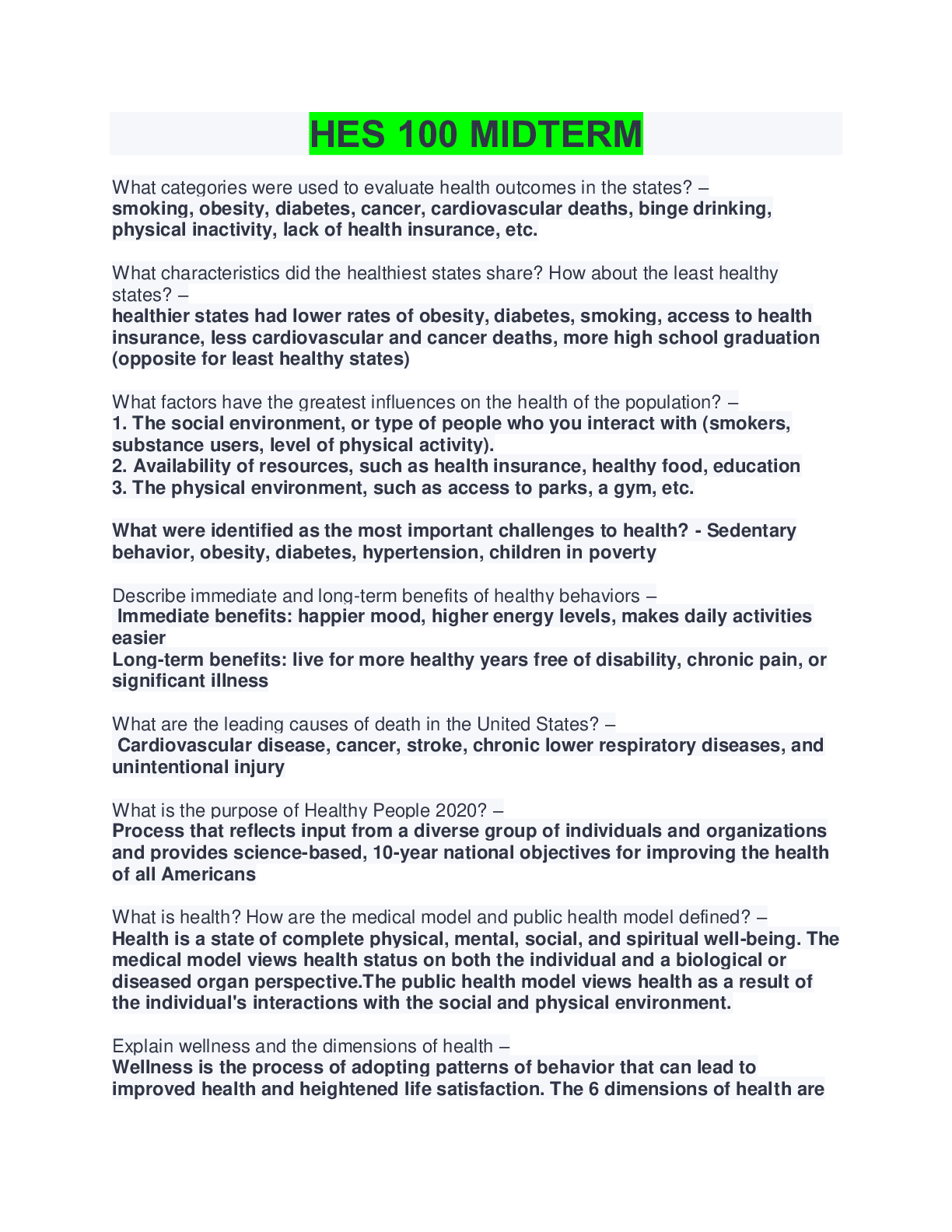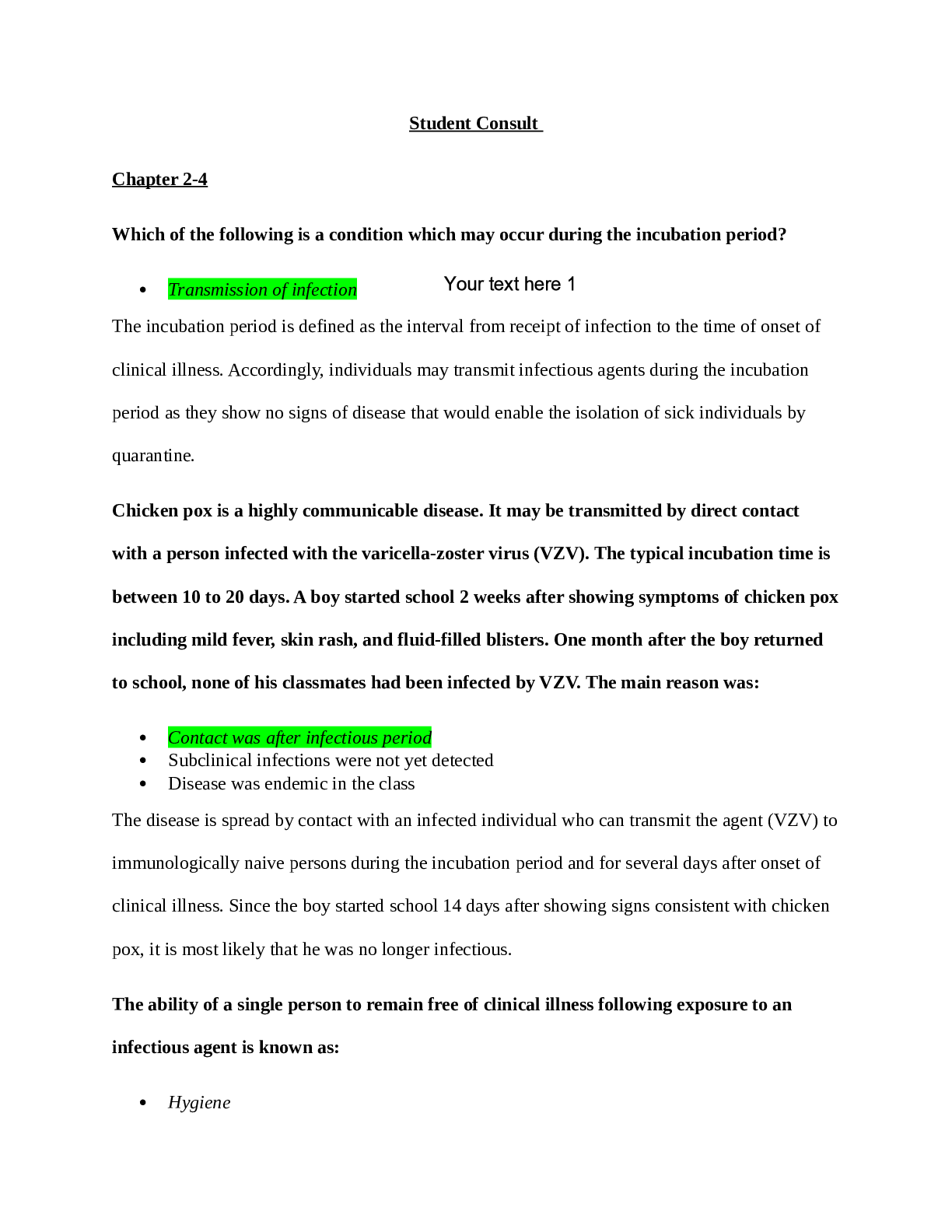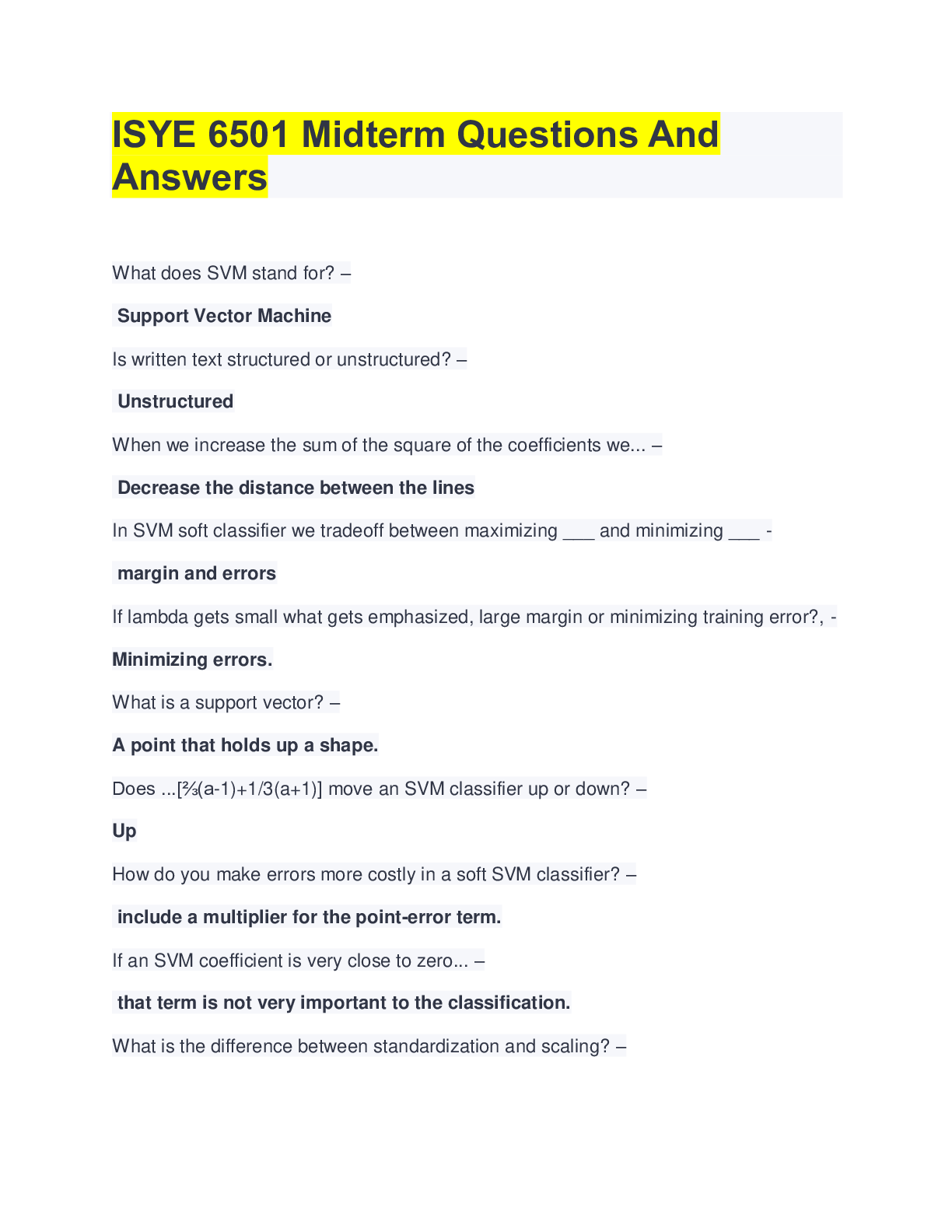NURS 3020 Midterm Questions and Answers latest updated,100% CORRECT
Document Content and Description Below
NURS 3020 Midterm Questions and Answers latest updated Question 1 1 out of 1 points Correct Ms. Otten is a 45-year-old patient who presents with a complaint of weight gain. Which medic... ation is frequently associated with weight gain? Selected Answer: Steroids Question 2 1 out of 1 points Correct In issues surrounding ethical decision making, beneficence refers to the: Selected Answer: need to do good for the patient. Question 3 1 out of 1 points Correct A detailed description of the symptoms related to the chief complaint is presented in the: Selected Answer: history of present illness. Question 4 1 out of 1 points Correct Mr. Williams, age 25, has recovered recently from an upper and lower respiratory infection. He describes a long-standing nasal dripping. He is seeking treatment for a mild hearing loss that has not gone away. Information concerning his chronic postnasal drip should be documented within which section of his history? Selected Answer: Past medical data Question 5 1 out of 1 points Correct Periods of silence during the interview can serve important purposes, such as: Selected Answer: providing time for reflection. Question 6 1 out of 1 points Correct Mr. Sanchez is a 45-year-old gentleman who has presented to the office for a physical examination to establish a new primary care health care provider. Which of the following describes a physical, not a cultural, differentiator? Selected Answer: Race Question 7 1 out of 1 points Correct A serous membrane that lines the abdominal cavity and forms a protective cover for many abdominal structures is the: Selected Answer: peritoneum. Question 8 1 out of 1 points Correct Mr. and Mrs. Johnson have presented to the office with their infant son with complaints of ear drainage. When examining an infant's middle ear, the nurse should use one hand to stabilize the otoscope against the head while using the other hand to: Selected Answer: pull the auricle down and back. Question 9 1 out of 1 points Correct The review of systems is a component of the: Selected Answer: health history. Question 10 1 out of 1 points Correct A 17-year-old girl presents to the clinic for a sports physical. Physical examination findings reveal bradycardia, multiple erosions of tooth enamel, and scars on her knuckles. She appears healthy otherwise. You should ask her if she: Selected Answer: binges and vomits. Question 11 1 out of 1 points Correct Mr. Black is a 44-year-old patient who presents to the clinic with complaints of neck pain that he thinks is from his job involving computer data entry. As the examiner, you are checking the range of motion in his neck and note the greatest degree of cervical mobility is at: Selected Answer: D. C4 to C5. Question 12 1 out of 1 points Correct The position on a clock, topographic notations, and anatomic landmarks: Selected Answer: are methods for recording locations of findings. Question 13 1 out of 1 points Correct Mrs. Tuber is a 36-year-old patient who comes into the health center with complaints that her fingernails are not growing. Which structure is the site of new nail growth? Selected Answer: C. Matrix Question 14 1 out of 1 points Correct Which cranial nerves innervate the face? Selected Answer: C. V and VII Question 15 1 out of 1 points Correct Tangential lighting is best used for inspecting skin: Selected Answer: contour. Question 16 1 out of 1 points Correct Mrs. Britton is a 34-year-old patient who presents to the office with complaints of skin rashes. You have noted a 4' 3-cm, rough, elevated area of psoriasis. This is an example of a: Selected Answer: A. plaque. Question 17 1 out of 1 points Correct Mr. Kevin Marks is a new health care provider. What is the best method to develop cultural competence? Selected Answer: Realize that cultural values are difficult to change and must be respected. Question 18 1 out of 1 points Correct What finding is unique to the documentation of a physical examination of an infant? Selected Answer: Fontanel sizes Question 19 1 out of 1 points Correct To perform the Rinne test, place the tuning fork on the: Selected Answer: mastoid bone. Question 20 1 out of 1 points Correct Percussing at the right midclavicular line, below the umbilicus, and continuing upward is the correct technique for locating the: Selected Answer: lower liver border. Question 21 1 out of 1 points Correct Mrs. Leonard brings her newborn infant into the pediatrician's office for a first well-baby visit. As the health care provider, you teach her that newborns are more vulnerable to hypothermia due to: Selected Answer: D. a poorly developed subcutaneous fat layer. Question 22 1 out of 1 points Correct Mr. Donalds is a 45-year-old roofer. Your inspection to determine color variations of the skin is best conducted: Selected Answer: C. with illumination provided by daylight. Question 23 1 out of 1 points Correct Before performing an abdominal examination, the examiner should: Selected Answer: have the patient empty his or her bladder. Question 24 1 out of 1 points Correct When palpating the abdomen, you should note whether the liver is enlarged in the: Selected Answer: right upper quadrant. Question 25 1 out of 1 points Correct Mr. L. presents to the clinic with severe groin pain and a history of kidney stones. Mr. L.'s son tells you that, for religious reasons, his father wishes to keep any stone that is passed into the urine filter that he has been using. What is your most appropriate response? Selected Answer: "With your father's permission, we will examine the stone and request that it be returned to him." Question 26 1 out of 1 points Correct Mrs. Kinder is a 39-year-old patient who presents to the office with complaints of an earache. In explaining to the patient about the function of her ears, which ear structure would you tell her is responsible for equalizing atmospheric pressure when swallowing, sneezing, or yawning? Selected Answer: Eustachian tube Question 27 1 out of 1 points Correct Ms. Davis is a 27-year-old patient with a BMI of 33. Based on her BMI, your diagnosis would be: Selected Answer: obese. Question 28 1 out of 1 points Correct Penicillin is considered a Selected Answer: “hot” medicine. Question 29 1 out of 1 points Correct Mrs. Raymonds is a 24-year-old patient who has presented for a routine concern over her current weight. In your patient teaching with her, you explain the importance of macronutrients. Which of the following is a macronutrient? Selected Answer: Fat Question 30 1 out of 1 points Correct The most common form of birth trauma of the scalp is: Selected Answer: caput succedaneum. Question 31 1 out of 1 points Correct Your patient returns for a blood pressure check 2 weeks after a visit during which you performed a complete history and physical. This visit would be documented by creating a(n): Selected Answer: progress note. Question 32 1 out of 1 points Correct During an interview, tears appear in the patient's eyes and his voice becomes shaky. Initially, you should: Selected Answer: offer a tissue and let him know it is all right to cry. Question 33 1 out of 1 points Correct Knowledge of the culture or cultures represented by the patient should be used to: Selected Answer: help make the interview questions more pertinent. Question 34 1 out of 1 points Correct When you are questioning a patient regarding alcohol intake, she tells you that she is only a social drinker. Which initial response is appropriate? Selected Answer: "What amount and what kind of alcohol do you drink in a week?" Question 35 1 out of 1 points Correct Which of the following is an "ABCD" characteristic of malignant melanoma? Selected Answer: Asymmetric borders Question 36 0 out of 1 points Incorrect You are palpating a patient's thyroid and find that its broadest dimension measures 4 cm. The right lobe is 25% larger than the left. These data would indicate: Selected Answer: B. a multinodular goiter. Question 37 1 out of 1 points Correct Macronutrients are so named because they: Selected Answer: are required in large amounts. Question 38 0 out of 1 points Incorrect Mr. Walters, a 32-year-old patient, tells you that his ears are "stopped up." An objective assessment of this complaint is achieved by using the: Selected Answer: otoscope with pneumatic attachment. Question 39 1 out of 1 points Correct Which is the best way to position a patient's neck for palpation of the thyroid? Selected Answer: C. Flexed toward the side being examined Question 40 1 out of 1 points Correct You are using an ophthalmoscope to examine a patient's inner eye. You rotate the lens selector clockwise, then counterclockwise to compensate for: Selected Answer: myopia. Question 41 1 out of 1 points Correct Ms. G. is being seen for her routine physical examination. She is a college graduate and president of a research firm. Although her exact salary is unknown, she has adequate health insurance. Most of the above information is part of Ms. G.'s history. Selected Answer: personal and social Question 42 0 out of 1 points Incorrect A 51-year-old woman calls with complaints of weight loss and constipation. She reports enlarged hemorrhoids and rectal bleeding. You advise her to: Selected Answer: exercise and eat more fiber. Question 43 1 out of 1 points Correct To approximate vocal frequencies, which tuning fork should be used to assess hearing? Selected Answer: 500 to 1000 Hz Question 44 1 out of 1 points Correct Your patient is complaining of acute, intense sharp epigastric pain that radiates to the back and left scapula with nausea and vomiting. Based on this history, your prioritized physical examination should be to: Selected Answer: inspect for ecchymosis of the flank. Question 45 1 out of 1 points Correct Mr. Marks is a 66-year-old patient who presents for a physical examination to the clinic. Which question has the most potential for exploring a patient's cultural beliefs related to a health problem? Selected Answer: “Why do you think you are having these symptoms?” Question 46 1 out of 1 points Correct Which of the following occurs when firm pressure is used to apply the stethoscope's bell end-piece to the skin? Selected Answer: It functionally converts to a diaphragm end-piece. Question 47 1 out of 1 points Correct Expected normal percussion tones include: Selected Answer: tympany over an empty stomach. Question 48 1 out of 1 points Correct Tuning forks with a frequency of 500 to 1000 Hz are most commonly used to measure: Selected Answer: hearing range of normal speech. Question 49 1 out of 1 points Correct Mr. Mathews is a 47-year-old patient who presents for a routine physical examination. On examination, you have noted a bruit heard over the thyroid. This is suggestive of: Selected Answer: B. hyperthyroidism. Question 50 1 out of 1 points Correct Unusual white areas on the skin may be due to: Selected Answer: C. vitiligo. Question 51 1 out of 1 points Correct A brief statement of the reason the patient is seeking health care is called the: Selected Answer: chief complaint. Question 52 0 out of 1 points Incorrect A 5-year-old child presents with nasal congestion and a headache. To assess for sinus tenderness you should palpate over the: Selected Answer: maxillary and frontal sinuses. Question 53 1 out of 1 points Correct Underestimation of blood pressure will occur if the blood pressure cuff's width covers: Selected Answer: more than two-thirds of the upper arm. Question 54 1 out of 1 points Correct Bulging of an amber tympanic membrane without mobility is most often associated with: Selected Answer: middle ear effusion. Question 55 1 out of 1 points Correct Mr. D. complains of a headache. During the history, he mentions his use of alcohol and illicit drugs. This information would most likely belong in the: Selected Answer: personal and social history. Question 56 1 out of 1 points Correct When recording physical findings, which data are recorded first for all systems? Selected Answer: Inspection Question 57 0 out of 1 points Incorrect Which question would be considered a leading question? Selected Answer: "What do you think is causing your headaches?" Question 58 1 out of 1 points Correct Differential diagnoses belong in the: Selected Answer: assessment. Question 59 1 out of 1 points Correct Mrs. Hartzell is a 34-year-old patient who has presented for nutritional counseling because she is a vegetarian. Deficiency of which of the following is a concern in the vegetarian diet? Selected Answer: Vitamin B12 Question 60 1 out of 1 points Correct Which of the following organs is part of the alimentary tract? Selected Answer: Stomach Question 61 1 out of 1 points Correct Peritonitis produces bowel sounds that are: Selected Answer: hypoactive. Question 62 1 out of 1 points Correct Pigmented, raised, warty lesions over the face and trunk should be assessed by an experienced practitioner who can distinguish: Selected Answer: D. seborrheic keratoses from actinic keratoses. Question 63 1 out of 1 points Correct Mr. Franklin is speaking with you, the health care provider, about his respiratory problem. Mr. Franklin says, "I've had this cough for 3 days, and it's getting worse." You reply, "Tell me more about your cough." Mr. Franklin states, "I wish I could tell you more. That's why I'm here. You tell me what's wrong!" Which caregiver response would be most appropriate for enhancing communication? Selected Answer: After 3 days, you're tired of coughing. Have you had a fever? Question 64 1 out of 1 points Correct Cherry angiomas are a common finding in: Selected Answer: adults older than 30 years. Question 65 1 out of 1 points Correct Tympanic thermometers measure body temperature when a probe is placed: Selected Answer: in the auditory canal. Question 66 0 out of 1 points Incorrect Auscultation should be carried out last, except when examining the: Selected Answer: heart. Question 67 1 out of 1 points Correct Mr. Johnson presents with a freely movable cystic mass in the midline of the high neck region at the base of the tongue. This is most likely a: Selected Answer: D. thyroglossal duct cyst. Question 68 1 out of 1 points Correct The attitudes of the health care professional: Selected Answer: are culturally derived. Question 69 1 out of 1 points Correct Coarse, dry, and brittle hair is associated with which metabolic disorder? Selected Answer: Hypothyroidism Question 70 1 out of 1 points Correct When hearing is evaluated, which cranial nerve is being tested? Selected Answer: VIII Question 71 1 out of 1 points Correct A blood pressure cuff bladder should be long enough to: Selected Answer: cover 75% to 80% of the arm circumference. Question 72 1 out of 1 points Correct Which technique is most likely to result in the patient's understanding of questions? Selected Answer: Use the patient's own terms if possible. Question 73 1 out of 1 points Correct Sweat glands, hair, and nails are all formed from: Selected Answer: C. invaginations of epidermis into dermis. Question 74 1 out of 1 points Correct A fixed image of any group that rejects its potential for originality or individuality is known as a(n): Selected Answer: stereotype. Question 75 1 out of 1 points Correct During percussion, a dull tone is expected to be heard over: Selected Answer: the liver. Question 76 1 out of 1 points Correct You have just completed a skin assessment on Mr. Baker. During your assessment, you have transilluminated a skin lesion. During the physical examination, you know that skin lesions are transilluminated to distinguish: Selected Answer: C. fluid-filled from solid cysts or masses. Question 77 0 out of 1 points Incorrect The adult recommended dietary fat intake should be g/day. Selected Answer: 20-35 Question 78 1 out of 1 points Correct Mr. Jones is a 45-year-old patient who presents for a physical examination. On examination, you note costochondral beading, enlarged skull, and bowed legs and diagnose him with rickets. A deficiency of which fat-soluble micronutrient can result in rickets? Selected Answer: Vitamin D Question 79 1 out of 1 points Correct Which of the following is an expected change in the assessment of the thyroid during pregnancy? Selected Answer: A bruit is auscultated. Question 80 1 out of 1 points Correct When taking a history, you should: Selected Answer: use a chronologic and sequential framework. Question 81 1 out of 1 points Correct Before performing an abdominal examination, the examiner should: Selected Answer: have the patient empty his or her bladder. Question 82 1 out of 1 points Correct A tool used to screen adolescents for alcoholism is the: Selected Answer: CRAFFT. Question 83 1 out of 1 points Correct White, rounded, or oval ulcerations surrounded by a red halo and found on the oral mucosa are: Selected Answer: aphthous ulcers. Question 84 0 out of 1 points Incorrect Recommended carbohydrate content of total dietary intake (% total calories) is %. Selected Answer: 50 Question 85 1 out of 1 points Correct When communicating with older children and teenagers, you should be sensitive to their: Selected Answer: typical reluctance to talk. Question 86 1 out of 1 points Correct George Michaels, a 22-year-old patient, tells the nurse that he is here today to "check his allergies." He has been having "green nasal discharge" for the last 72 hours. How would the nurse document his reason for seeking care? Selected Answer: G.M. is a 22-year-old male here for having “green nasal discharge” for the past 72 hours. Question 87 1 out of 1 points Correct The term denoting the caregiver's need to do no harm to the patient is: Selected Answer: nonmaleficence. Question 88 1 out of 1 points Correct You are planning to palpate the abdomen of your patient. Which part of the examiner's hand is best for palpating vibration? Selected Answer: Ulnar surface Question 89 1 out of 1 points Correct Mrs. Berger is a 39-year-old woman who presents with a complaint of epigastric abdominal pain. You have completed the inspection of the abdomen. What is your next step in the assessment process? Selected Answer: Auscultation Question 90 1 out of 1 points Correct Which of the following is the most accurate reflection of an individual's food intake? Selected Answer: Food diary Question 91 1 out of 1 points Correct You are completing a general physical examination on Mr. Rock, a 39-year-old man with complaints of constipation. When examining a patient with tense abdominal musculature, a helpful technique is to have the patient: Selected Answer: flex his or her knees. Question 92 1 out of 1 points Correct Mrs. Grace is a 58-year-old patient who has a diagnosis of pernicious anemia. Which B vitamin is deficient in patients with pernicious anemia? Selected Answer: B12 Question 93 1 out of 1 points Correct A college student comes to the student health center complaining of difficulty in concentrating during class and while studying. The diet that would contribute to this problem is one that consumes mostly: Selected Answer: lean meat and fish. Question 94 1 out of 1 points Correct Your patient is complaining of acute, intense sharp epigastric pain that radiates to the back and left scapula with nausea and vomiting. Based on this history, your prioritized physical examination should be to: Selected Answer: inspect for ecchymosis of the flank. Question 95 1 out of 1 points Correct Regardless of the origin, discharge is described by noting: Selected Answer: color and consistency. Question 96 1 out of 1 points Correct As part of your health promotion education for a new patient, you explain that the risk factors for skin cancer include: Selected Answer: repeated trauma or irritation to skin. Question 97 1 out of 1 points Correct Which statement is true regarding the relationship of physical characteristics and culture? Selected Answer: There is a difference between distinguishing cultural characteristics and distinguishing physical characteristics. Question 98 1 out of 1 points Correct When assessing abdominal pain in a college-age woman, one must include: Selected Answer: the first day of the last menstrual period. Question 99 1 out of 1 points Correct Which part of the information contained in the patient's record may be used in court? Selected Answer: All information Question 100 1 out of 1 points Correct Spasmodic muscular contractions of the head, face, or neck are called: Selected Answer: B. tics [Show More]
Last updated: 1 year ago
Preview 1 out of 73 pages
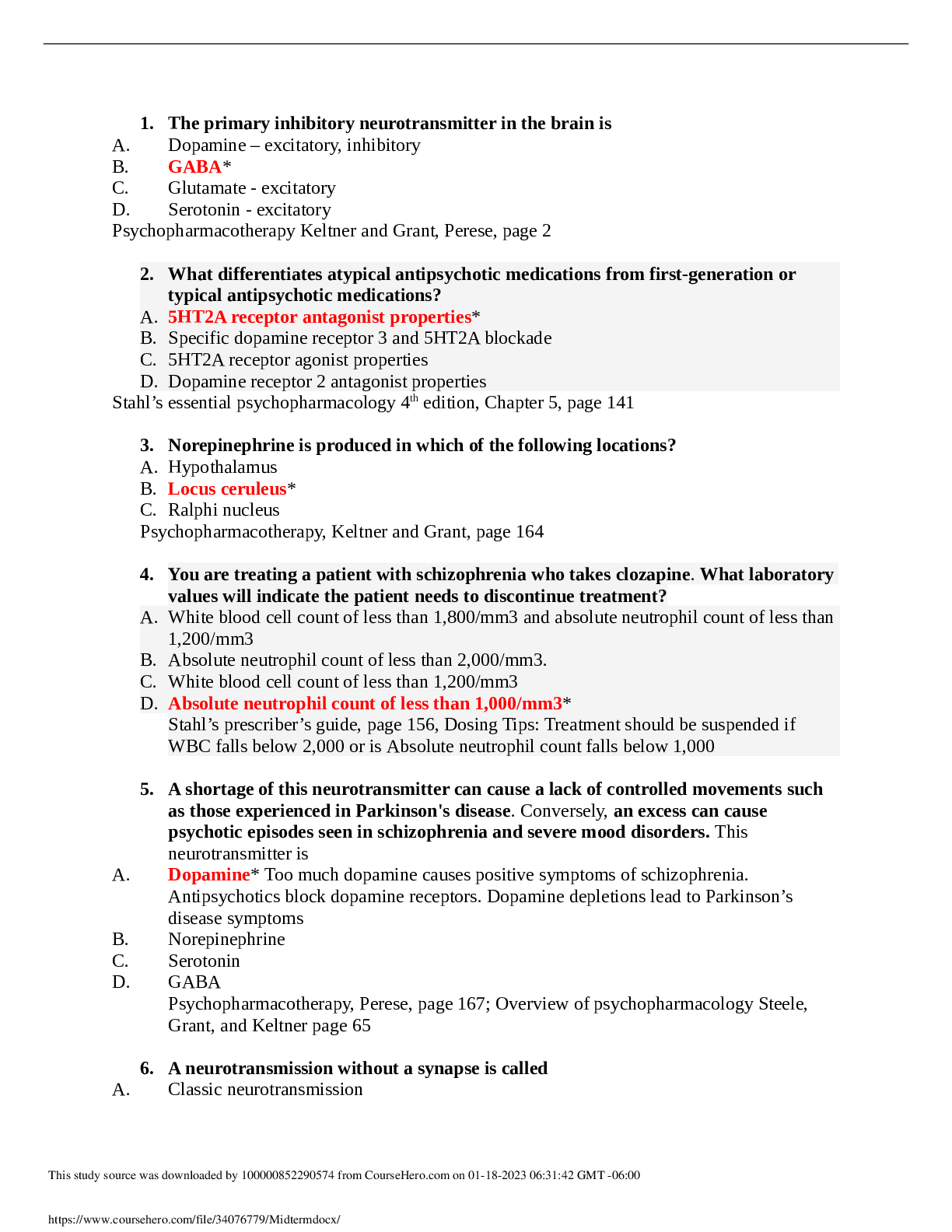
Reviews( 0 )
Document information
Connected school, study & course
About the document
Uploaded On
Jul 19, 2022
Number of pages
73
Written in
Additional information
This document has been written for:
Uploaded
Jul 19, 2022
Downloads
0
Views
36














